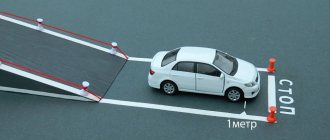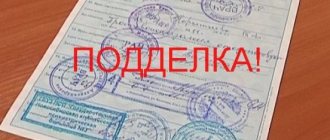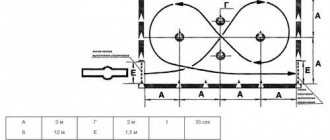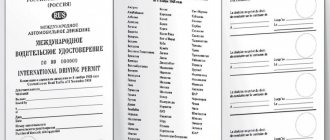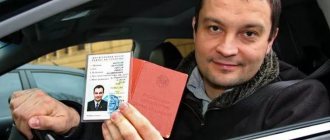All bus drivers need a driver's license, and here it is important to know that buses are different, therefore, the category of driver's license for a bus driver needs one that is suitable for one or another type of transport. If the driver drives any vehicle without the required license category, then he will face a fine in the amount of 5,000 to 15,000 rubles (Article 12.7 of the Code of Administrative Offenses of the Russian Federation).
In total, there are 3 categories for vehicles that can transport people: B, D and D1. Each of them determines what type of bus you can drive. It all depends on the weight of the vehicle, the number of seats in the cabin and the type of bus itself. But first things first.
Driving license category D – what is it?
A category D driver's license is a document issued by the territorial traffic police, containing on the reverse side a note indicating that the citizen is authorized to drive buses and other vehicles with more than 8 seats, specially designed for organized passenger transportation. Also, a category D driver's license in 2021 allows you to drive a vehicle with more than 8 passenger seats, coupled to a trailer, the maximum permitted weight of which does not exceed 750 kilograms (Part 1 of Article 25 of Federal Law No. 196).
Attention! If you have any questions, you can chat for free with a lawyer at the bottom of the screen or call Moscow; Saint Petersburg; Free call for all of Russia.
Upon receipt of a driver's license with category D, access to expanded categories of rights opens:
| Category | Description |
| D | Buses that have 9 or more passenger seats - either without a trailer at all, or with one (provided that its weight is less than or equal to 750 kg). |
| D1 | Buses equipped with a number of seats for citizens ranging from 9 to 16 inclusive - either without a trailer or with it (provided that its weight is less than or equal to 750 kg). |
| DE | Articulated buses or vehicles classified as D, but with a trailer whose mass exceeds 750 kg. |
| D1E | Buses classified as D1, but with a trailer whose documented mass, although greater than 750 kg, does not exceed the unladen weight of the bus (and the total weight of the road train must not exceed 12,000 kg, otherwise DE will be required). |
Categories of tractor licenses: decoding
- Topics related to the theory of safe control of self-propelled vehicles.
- Topics related to the use of specific vehicles and related equipment.
- Traffic rules theory.
- A practical exam covering all theoretical knowledge acquired.
- "A". This includes vehicles that are not designed to travel on highways that have general purpose status; This also includes self-propelled vehicles, the maximum speed of which is 50 km/h. Be careful! Category “A3” in a tractor license does not belong to this group! Having “A”, you can control:
- Off-road motor vehicles.
- Off-road vehicles with a maximum total weight of no more than 3.5 tons, and a number of passenger seats of no more than 8.
- Off-road vehicles weighing more than 3.5 tons (except for equipment that is included in IV). Again, we repeat that category “A3” in the new tractor license does not belong to this group.
- Off-road vehicle transport, where the number of passenger seats will be more than 8.
- "IN". Tracked and wheeled vehicles with an engine power of no more than 25.7 kW.
- "WITH". Wheeled vehicles, the power of which varies between 25.7-110.3 kW.
- "D". Category “D” tractor licenses provide the ability to drive wheeled vehicles with a power of more than 110.3 kW.
- "E". Tracked self-propelled vehicles with a motor power of more than 25.7 kW.
- "F". Category of agricultural self-propelled transport.
We recommend reading: Do they give land for a third child in Bashkortostan?
What vehicles can be driven with category D?
In accordance with Part 1 of Art. 25 Federal Law No. 196, a citizen who has received a driving license with mark D, in 2021, acquires the opportunity to absolutely legally drive vehicles that are intended for passenger transportation and that have more than 8 seats, that is, 9, 10, 11, 12, and so on further (not counting the driver's seat).
Simply put, having D, a person gets the right to drive a variety of buses (regardless of their weight and passenger capacity) - from the smallest to the largest (except articulated ones).
Category D license also allows you to drive buses with trailers, provided that the weight of the latter does not exceed 750 kilograms.
If the trailer weighs more than 750 kilograms, you will have to get DE. With the DE category you can manage:
- any buses with a trailer if the weight of the latter is 750 kg. or more;
- articulated vehicles.
Category DE rights can be opened only after receiving category D. In ab. 5 hours 2 tbsp. 26 Federal Law No. 196 clearly states this - the right to drive vehicles classified as DE is granted to persons who have a driver’s license with category D for at least 1 year or more.
What exams do you need to take for category D?
Exams for category “D” can only be taken after completing the appropriate training.
This training is carried out in 2 stages and includes theoretical and practical parts.
The theoretical part consists of classes in a driving school, where, under the guidance of a teacher, traffic rules, the design of vehicles of category “D”, the basic rules for passenger transportation, the basics of safe bus driving, as well as the basics of first aid and conflict resolution are studied.
Practical classes are aimed at learning to drive and in the first stages are conducted at a race track with a driving school instructor. During such classes, future drivers acquire knowledge and practice driving away on an incline, making turns, entering a box, etc. At the second stage, future drivers learn to drive on the roads.
Category "D": exam stages
The exam to obtain category “D” is carried out in 2 stages and consists of a theoretical and practical exam on driving a vehicle on a race track.
1. Theoretical exam – tickets for the exam for category “D” are the same as tickets for categories B-C. So you can simultaneously take the theoretical part to obtain categories C and D.
2. Driving (practical part on the race track) – here the driver must complete one of the following tasks (at the examiner’s choice):
Option #1
- start and then stop on an incline;
- parking (parallel), performed in reverse;
- "snake".
Option No. 2
- start and then stop on an incline;
- parking (parallel), performed in reverse;
- reversal
Option #3
- start and then stop on an incline;
- entry to the box;
- "snake".
The final stage of the practical part of the exam is driving in the city.
In conclusion, I would like to note that there are no fundamental differences in passing the exam for category “D” in comparison with the exam for category “B”. However, it is very important to acquire the skills to adequately drive a bus, since driving such a vehicle is much more difficult than driving a regular passenger car.
Last update: 04-09-2020
At what age can you get a D?
Based on Part 2 of Art. 26 Federal Law No. 196, only persons who are over 21 years old can take exams and receive a driver’s license with a mark indicating the ability to drive category D vehicles.
At the same time, it is not allowed to take exams before reaching the specified age (as, for example, this is possible in relation to category B - that is, a person can undergo training at a driving school, pass theory, practice at the race track and the city upon reaching 17 years of age, and already at 18 simply receive VU - part 3 of article 26 of Federal Law No. 196).
In 2021, there is an exception to the above rule. If a citizen undergoes military service, upon appropriate assignment from a military unit, he has the right to unlearn and take exams for D , starting at the age of 19 (Part 4 of Article 26 of Federal Law No. 196). Until he reaches the age of 21, he will be able to travel only on buses assigned to military organizations. And after reaching this age, it will be possible to drive civilian passenger vehicles.
What cars can you drive with category D?
Category D is issued only to drivers who have experience driving vehicles. Often, driving a vehicle with the specified characteristics is the professional activity of the driver.
Category D refers to the following types of transport:
- buses for transporting passengers with more than 8 seats, these include so-called minibuses, for example, Gazelle models for 10 people;
- mechanisms with a trailer of the specified category, the weight of which reaches no more than 750 kg.
Category D has subtypes based on the new law:
| D1 | Cars with a number of passenger seats from 9 to 16, and buses with trailers up to 750 kg |
| DE | Buses with a trailer weighing more than 750 kg, as well as those with two passenger compartments like an “accordion”, as in Ikarus model cars |
| D1E | Buses with 9-16 seats for passengers, a trailer not used to accommodate a passenger compartment, the weight of which reaches a maximum limit of 12 tons |
Subcategories with the designation D are characterized by the following features:
- drivers with category D1E can drive vehicles falling under DE;
- If you have category D, the driver is allowed to drive in subcategory D1., which belongs to category “D1”.
The driver's license contains the following information:
- Full name of the person authorized to drive the vehicle in Russian and Latin script;
- start and end dates of the driver's license;
- permitted driving categories indicating subcategories;
- region of issue of rights;
- branch of the traffic police department that issued the certificate;
- photograph of the driver with his personal signature.
Based on the 2021 law, information has been added:
- about blood group;
- wearing glasses.
Photographs with hats are now allowed if wearing them is required for religious reasons, as well as with glasses if the driver wears them regularly.
It is prohibited to issue a driver's license for the following types of chronic diseases:
- myopia up to 3 diopters;
- previous eye surgery;
- deafness;
- absence of phalanges or complete fingers;
- cardiovascular diseases;
- diabetes, etc.
Other diseases may be recognized as grounds for prohibiting the issuance of a certificate on an individual basis by decision of doctors collectively consisting of at least 3 people.
The procedure for issuing an electronic OSAGO policy at VTB Insurance is described in the article: OSAGO VTB Insurance. Is a technical inspection required for MTPL insurance in 2020? Find the answer on this page.
Difference between rights categories D and D1
If a citizen plans to drive a vehicle with a not too large passenger capacity, then you can not receive the main category D, but pass the exams for a lower one - D1.
In accordance with Part 1 of Art. 25 Federal Law No. 196, if you have D1 on your driver’s license, you can ride the following buses:
- which have from 9 to 16 passenger seats inclusive;
- or which have the same passenger capacity, but are also coupled to a trailer whose weight is up to 750 kg..
There is also a subcategory D1E. It will be needed by the citizen who plans to travel on buses belonging to class D1, with a trailer weighing 750 kilograms or more. In addition, two conditions must be met simultaneously:
- the weight of the towbar should not exceed the weight of the bus without load;
- the total weight of the structure (vehicle + trailer) is no more than 12 tons.
If at least one of the above conditions is not met, you will need to obtain the DE category in 2021.
Particular attention should be paid to the following conditions:
- D1, like D, can be opened starting from the age of 21;
- Having received D1, the driver will not be able to drive a vehicle of category D (in other words, you cannot drive a bus with a D1 license that has 17, 18, 19 or more passenger seats);
- the presence of category D in a driver's license confirms the right to drive a vehicle of class D1 (Part 7, Article 25 of Federal Law No. 196) - in other words, if a person opens D, then he is automatically marked with D1 on his license.
Basic Concepts
With the introduction of new rules, categories and subcategories appeared that were not previously in the traffic rules.
Classification is now carried out according to the following criteria:
| A | Motorcycles |
| M | Scooters and mopeds with engine capacity up to 50 cc. |
| IN | Passenger cars, B1 – tricycles and quadricycles, BE – cars with trailers up to 750 kg |
| D | Transport for passenger transportation, including composite vehicles with two compartments (D1E) and a trailer in the DE subcategory |
| WITH | Vehicles with medium load capacity, with a trailer up to 750 kg in the CE subcategory, C1E also stands out |
| Тm | Trams |
| Tb | Trolleybuses |
A special feature of the new law was the abolition of category E, which previously applied to vehicles with a high load capacity of over 7,500 kg.
If there is no category of rights when driving a vehicle of a certain type, a fine in the amount of 5,000 to 10,000 rubles is imposed. When a traffic accident occurs, it is considered that the person was driving the vehicle without the appropriate permit, which entails the deprivation of a driver’s license of another category as part of administrative proceedings.
Requirements for receiving D
Formally (by law), to obtain the right to drive category D buses, you must:
- reach 21 years of age;
- attend a driving school;
- do not have relevant medical contraindications;
- successfully pass theory, practice at a specialized race track, as well as an exam conducted in urban traffic conditions.
Judging by Part 2 of Art. 25 Federal Law No. 196, the right to register categories B, C, D, A, and others is given to:
- those who passed the exams;
- who has reached the appropriate age.
Based on clause 17 of Resolution No. 1097, those who are allowed to take the exams:
- has a medical certificate stating that he has no contraindications to driving;
- completed training at a driving school.
At the same time, nowhere in the legislation does it say that to open D you need to have so many years of driving experience or other categories.
But this is stated in unofficial sources and even on the websites of many driving schools. It says that to enroll in training you need:
- have B and C already open;
- have over 3 years of driving experience;
- make a medical record;
- have no contraindications to driving.
These requirements are not imposed by the traffic police, but by the driving schools themselves.
How to get
You can drive a category D vehicle only if the following conditions are met:
- presence of category B or C;
- continuous driving experience of 3 years;
- completing a special driving school training course;
- confirmation of good health upon provision of a medical record with the necessary qualifications from doctors.
Obtaining a certificate of this type can be divided into the following stages:
- Taking a course at a driving school to train passenger transport drivers. Only drivers who have confirmed the presence of category B or C for 3 years are allowed to train and take the exam. In this capacity, not only the indication of categories on the driver’s license is considered, but also the availability of technical passports and protocols on the actual driving of the vehicle.
- Based on the results of listening to the course, you must pass a qualifying exam at a driving school and the traffic police. The practical part is checked by employees of the traffic control organization. You can take the exam only if you provide the driver's medical card and identification card; without this, candidates are not allowed to take the test. Simultaneously with category D, you can apply to take the exam in form C for freight transport.
- Upon successful examination, an application is submitted to the traffic police with a package of documents to obtain a driver's license with a new category in place of the previous ones, where only B is indicated. The exam is accepted and documents are issued only at the traffic police department at the place of permanent registration of the candidate.
Cost of training for category D license
Training for a driver's license category D is carried out on the basis of an agreement on the provision of paid educational services. It should indicate:
- full cost;
- payment procedure (immediately or in installments) (Part 3 of Article 54 of Federal Law No. 273 of December 29, 2012).
There is no government regulation of prices. Therefore, each school sets its own prices.
In 2021, the average cost of training varies from 30 to 50 thousand rubles and depends on:
- pricing policy of a particular educational institution;
- subject of the Russian Federation;
- number of academic hours of theory and practice.
Payment usually includes:
- the cost of fuels and lubricants for a training machine;
- post-lecture consultations with the teacher in case of missed classes;
- preparation of a package of documentation for the traffic police (certificate of completion of training, driver’s card).
In some cases, the price also includes a set of educational literature (examination tickets, a book with Traffic Rules, etc.).
Required documents
To obtain a driving category, you must provide the following official documents to the traffic police at your place of registration:
- an application in a form available for download on the official website of the road service or at a branch of a government agency from a specialist accepting documents;
- medical record with notes from all specialists (surgeon, ENT specialist, ophthalmologist, surgeon, narcologist, psychiatrist) with o;
- a receipt for payment of the state duty in the original and a copy, the cost today is, based on the requirements of the Tax Code of the Russian Federation, 2,000 rubles, payment is made at bank cash desks or online when submitting an application for a replacement certificate through the State Services portal;
- confirmation of payment of fines for participation in administrative offenses earlier;
- a driver's license with a category B stamp for 3 years;
- confirmation of driving a vehicle for a minimum period of 3 years - technical passports for the vehicle in copies, protocols on administrative offenses, other marks.
The certificate of completion of training in a driving school for category D is characterized by the following points:
- study of traffic rules with an emphasis on bus traffic rules;
- knowledge of the design of a vehicle for passenger transportation, technical components for emergency replacement;
- basic safety when driving a bus;
- first aid rules;
- ways to resolve conflict situations on the road.
The document is issued in the region of registration. There should also be a driving school where training was provided. Both confirmation of permanent and temporary registration at the location address will be suitable.
Currently, all foreigners are required to obtain Russian driver's licenses. This means that in addition to a foreign passport, it is necessary to provide a migration card confirming entry into Russia and crossing the state border, as well as a notification of temporary registration, certified by the migration service at the place of permanent residence.
These documents must be submitted to the traffic police department along with a medical card and a certificate of completion of training at a driving school.
Training in both theoretical and practical parts is carried out under the supervision of an experienced instructor.
The following points are trained:
- Exercise 1. Parallel parking, moving from a place, performing a “snake”.
- Exercise 2. Stopping and starting on a hill, parallel parking in reverse and turning around.
- Exercise 3. Starting off with a stop on the rise, snake and entering the box.
A mandatory part of the test program is a trip to the city to test your driving skills.
Driving category D vehicles is associated with ensuring increased safety for passengers and differs from driving passenger vehicles, which is why it is necessary to demonstrate vehicle driving skills at the test site and in the city in the presence of traffic police officers to pass a qualification exam.
How to get a D in 2021 - step-by-step instructions
Registration of the right to drive buses is carried out according to the following algorithm:
- checking yourself for compliance with the requirements (age - from 21 years, driving experience - from 3 years, availability of already opened B, C, issued medical book);
- choosing a school based on reviews from friends, acquaintances or other people who have already graduated, by price factor, by distance from the place of residence, by personal preferences (it is also mandatory to check whether the educational organization has a license , and to clarify addresses, contact numbers and a list of categories, for which training is provided, you can use a special service from the traffic police);
- conclusion of an agreement on the provision of paid services;
- making payment in full or in installments, providing the school with relevant payment documents;
- attendance at theoretical and practical classes (in accordance with the curriculum, it can be clarified at the school itself);
- obtaining a certificate of completion of training;
- visit to the territorial State Traffic Inspectorate, provision of an application and documents necessary for passing the exams and issuing a driving license;
- obtaining details for paying state duty and making a payment at any bank (2000 rubles);
- waiting for a traffic police official to check the submitted documents and information in accordance with clauses 60 - clause 75 of Order of the Ministry of Internal Affairs No. 995 (for forgery, for the presence of data on the deprivation of the applicant’s rights, etc.);
- waiting for the appointment of exam dates (clause 76.1. Order of the Ministry of Internal Affairs No. 995);
- passing theory and practice on the racetrack and in the city;
- clarification from the traffic police when you can pick up a ready-made driver’s license with open category D;
- receiving it in your hands on the appointed date and time.
In 2021, documents specifically for issuing licenses with category D do not need to be submitted separately (the applicant has already submitted them before passing the exams).
The driver is not required to provide photographs, so the traffic police officers themselves take the photographs on the day they receive a new driver’s license.
How and where to get category “D”
If you need to get a category that allows you to drive a bus, you will have to spend a lot of effort and time, since you will need to attend a driving school for 2 months, thoroughly study the traffic rules, and also learn the techniques of driving a bus.
In short, to obtain a driving license with an open category “D”, the following conditions must be met:
- have rights with open categories C or B;
- have at least 3 years of driving experience;
- pay for driving school tuition;
- have a medical book.
If we consider the entire procedure in more detail, then to obtain category “D” the driver needs to act in stages.
Stage No. 1. Driving school training
Obtaining category “D” by a driver will require him to have documents that will confirm that he has at least three years of driving experience. Such documents are rights (category B), registration certificates, protocols, etc.
Training at a driving school costs 30,000-40,000 rubles and will take 2.5 months, after which you will need to pass an exam. To prepare well for this exam, you should attend 24 theoretical classes and 14 driving lessons (practical classes) at a driving school.
It should be noted that most driving schools provide LAZ buses for driving lessons.
Practical training is very important, since driving a bus is a much more complex process than driving a regular car. There are some nuances here that the instructors will teach you.
Stage No. 2. Exam
When you complete your driving school course (theoretical and practical classes), you will need to take an exam.
Please note that before taking the examination tests, you will need to provide a passport and medical record. Without these documents, you simply will not be allowed to take the exam.
Please note that upon receiving category “D”, you have the right to take the exam for category “C” in parallel. It is worth taking advantage of this opportunity, because this category of rights will not be superfluous.
Stage No. 3. Getting a category
After passing the exam (successfully), you need to come to the driving school with your old license, take a photo and get a license with category “D”.
Examinations are accepted and a driving license is issued at the examination departments of the State Traffic Safety Inspectorate within the constituent entity of the Russian Federation in which the potential driver is registered (registered) at his place of residence, place of temporary residence or stay.
At the request of a person who wants to receive category “D”, the examination and subsequent issuance of a driving license of the required category can be carried out in the examination department at the location of the educational organization (driving school) where the driver was trained.
Theoretical exam for license category D
In accordance with paragraphs. “a” clause 9 of Resolution No. 1097, in order to obtain a driver’s license category D, you must pass the theory.
The procedure for conducting a theoretical exam for driving license category D:
- first, the traffic police official establishes the identity of the examinees, introduces them to the automated workstation (AWS) where knowledge control will be carried out (clause 85 of Order of the Ministry of Internal Affairs No. 995), and answers additional questions;
- then all candidate drivers are seated at an automated workplace, where they are asked to answer 20 questions, combined into 4 thematic blocks (5 questions in each block) (clause 92 of Order of the Ministry of Internal Affairs No. 995) - the answer options can be from 2 to 5, with In this case, only one of them is always correct;
- after answering all the questions or after the set time has elapsed (a total of 20 minutes), a grade of “Pass” or “Fail” is given, about which the relevant information is entered into the examination sheet (clause 100 of Order of the Ministry of Internal Affairs No. 995).
“Failed” will be (without any opportunity to correct anything, that is, they won’t give additional questions), if you do:
- 3 errors, each of them in different thematic blocks;
- 2 errors IN THE SAME thematic block (clause 97 of the Order of the Ministry of Internal Affairs No. 995).
But you can still fix it if:
- out of 20 questions, answer only 1 incorrectly - then you need to answer 5 additional questions within 5 minutes (if you answer them correctly, it will be “Pass”, if you make an error in at least one, that’s it, you will be sent for a retake);
- out of 20 questions, answer 2 incorrectly, but IN DIFFERENT BLOCKS - then you need to answer 10 questions correctly in 10 minutes (and again you need to give the correct answer to all these additional questions - then they will give a “Pass” grade, otherwise the examinee should retake – clause 99 and clause 97.3 of the Order of the Ministry of Internal Affairs No. 995).
Practice on the racetrack and in the city
If the theory has been successfully passed, then the candidate driver is allowed to take a practical test at a specialized race track (clause 11 of Resolution No. 1097), otherwise he will first have to take a retake.
Passing the exam for obtaining a category D license at the race track in 2021 is as follows:
- first, the examiner checks the bus for operability, video cameras recording the passing process, compliance of the equipment of the test exercise areas with the established requirements (cones, markings) (clause 106 of Order of the Ministry of Internal Affairs No. 995);
- Next, the driver’s identity is checked;
- then the candidate, at the examiner’s command, sits in the driver’s seat and prepares to begin the exercises (fastens his seat belt, adjusts the rear-view mirrors), after which he confirms his readiness to start by turning on the low beam headlights (clause 11 of Appendix 7 to Order of the Ministry of Internal Affairs No. 995);
- at the examiner’s signal, the exercises begin: “Stopping and starting to move on an uphill slope,” “Maneuvering in a confined space,” “Reversing into a box,” “Parking a vehicle and leaving it,” “Stopping for safe boarding and disembarking of passengers.” , “Traveling through a controlled intersection.”
In 2021, a “Fail” grade will be assigned if, for example:
- the engine stalled 3 or more times (clause 113.7. Order of the Ministry of Internal Affairs No. 995);
- cones were hit 3 or more times;
- the driver moved in reverse while performing exercises where this is prohibited;
- the vehicle was allowed to roll back by 30 centimeters when stopping and starting to move on an incline.
After successfully passing the circuit, a time and place for the exam will be scheduled in the city . Preparation for it is carried out in approximately the same way as at the race track (that is, the examiner checks the readiness of the vehicle and video monitoring equipment; on command, the driver takes his seat, checks the mirrors, fastens his seat belt, etc.).
Then the movement begins along the established route. At the examiner’s command, the driver must perform the appropriate actions specified in clause 2 of Appendix 2 to Resolution No. 1097 (overtake, stop to allow citizens to pass at a pedestrian crossing, drive through an unregulated intersection of equal and unequal roads, etc.).
The examiner evaluates how the candidate complies with traffic rules and, if mistakes are made, assigns penalty points:
- 5 – for gross mistakes;
- 3 – for average;
- 1 – for small ones (clause 129 of Order of the Ministry of Internal Affairs No. 995).
If you score more than 5 or more penalty points, the exam will be considered failed.
What does a Category D university look like?
In 2021, a category D driver's license is a small rectangular document measuring 8.56 by 5.4 centimeters.
On the front part there is a photograph of the driver and basic information about him (full name, date and place of birth), as well as the validity period, series and number of the driver's license, the name of the traffic police department that issued the document, and the region of registration of the motorist. Column 9 indicates all types of cars that the driver can drive (including D).
On the reverse side there is a table indicating the categories of vehicles, the start and end dates of the right to drive them, and a field for making special notes.
Tractor driver's license
Category A III is an analogue of category C, and category A IV is an analogue of category D. That is. Having a category A IV tractor driver's license, you can also drive off-road minibuses that can bypass city traffic jams through nearby swamps.
We recommend reading: If a retired military man dies, who receives his pension?
2. Self-propelled machines in these Rules mean tractors, self-propelled road-building machines and other ground-based trackless mechanical vehicles with independent drive and having an internal combustion engine with a volume of over 50 cubic meters. centimeters or an electric motor with a maximum power of more than 4 kW (with the exception of motor vehicles intended for movement on public roads with a maximum design speed of more than 50 km/h, and self-propelled combat vehicles of the Armed Forces of the Russian Federation, other troops, military formations and bodies performing tasks in the field of defense and state security).
Is it possible to open D without having B and C?
By law - yes. However, all driving schools do not accept citizens to study for D if they do not have B and C, as well as 3 years of driving experience.
It turns out to be a vicious circle - according to the law, you can reach 21 years of age and go to study for a D, even without ever driving a car or truck, but in practice, the school will simply refuse to conclude an agreement. And without a certificate of completion of training, you cannot get a bus license.
Training period
The cost of training is quite high - from 30,000 to 40,000 rubles. The course lasts approximately 2.5 months. The driving school certificate must include 24 hours of theory and at least 14 hours of practical training in driving maneuvers on the racetrack and within the city limits. Most schools provide a LAZ shooting range bus for training. Training is carried out under the supervision of experienced instructors.
Only persons over 21 years of age are allowed to study and take the exam. Moreover, driving experience confirmed in category B must be at least 3 years at the time of application.
Requirements must be met:
- have the right to drive a vehicle of category DE, that is, a bus with a trailer, only to citizens who have experience driving vehicles in category D for more than 1 year;
- To study for category D1E, you must have driving experience in vehicles of category D or subcategory D1 for a period of at least 1 year.
When performing military service, it is allowed to be granted driving rights in category D1 upon reaching the age of 20 years. They can drive vehicles belonging to the Armed Forces of the Russian Federation and military units in category D until they reach the age of 21.
The features of E-MTPL in MAX are discussed in the article: MTPL in MAX. Read the documents for payment under compulsory motor liability insurance here.
Find out how to pay a traffic police fine without commission via the Internet at Tinkoff here.
